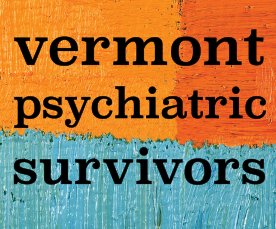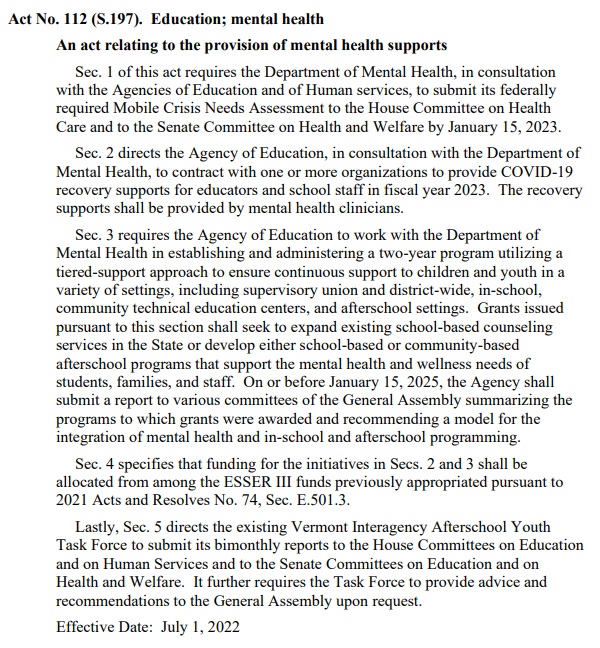Starting in July, the Vermont Agency of Education (AOE) will administer a two-year program whereby, in consultation with the Department of Mental Health (DMH), it will disburse grants for youth programming in schools and community settings.
Legislation passed on April 27 specifies that grant applicants must employ “evidence-based strategies to address students’ social, emotional, mental health, and wellness needs” and collect data to demonstrate their effectiveness. Committees received testimony by representatives from Vermont Afterschool; MENTOR Vermont; Mental Health First Aid, whose model the law mentions by name; and Designated Agencies that employ school-based clinicians.
Introduced by Sen. Ginny Lyons, S. 197 initially set out to create a working group that would have endeavored to design “a coordinated system of response to mental health crises” among police departments, hospitals, and the Designated Agencies. At a Feb. 11 meeting of the Senate Committee on Health and Welfare, however, the senator announced that the bill would “take a turn toward youth.”
Since the onset of the COVID-19 pandemic, parents, educators, counselors, emergency room physicians, and others have expressed alarm at signs of escalating psychological stress among Vermont’s young people. Grants under S.197 will target organizations that provide “opportunities for children and youth to participate in activities that heal and prevent social isolation, such as outdoor activities, art therapy, recreation, and time in nature,” as well as those that can create “partnership[s] with classroom teachers and school guidance counselors to coordinate supports, communication, and strategies.”
Superintendent Lynn Cota of the Franklin Northeast Supervisory Union supported the bill. “I’m sure you all already understand the crisis that we’re feeling in our Vermont schools and the magnitude and the complexity of the mental health needs and the resulting behavior manifestations that we’re all seeing,” she told legislators. “It’s really taxing the capacity that we have and the level of expertise that we have within our schools in order to support those students.”
Sen. Ann Cummings wondered whether a two-year program could make a lasting difference in schools. “We have services there that we’re severely underfunding, and we’re setting up new temporary programs. For a kid to start something and build a relationship and then have it end could do a lot of damage,” she cautioned Lyons.
The legislation suggests, however, that the grant program will aim to supply “a model for the integration of mental health and in-school and afterschool programming” that AOE could seek to sustain, in some fashion, beyond the mandated two years. The legislature will receive a report on the matter from AOE by early 2025.
Lyons first sought to tap unreserved ESSER III dollars to pay for the grants. ESSER (Elementary and Secondary School Emergency Relief), a federal program, aimed to help schools respond to the impacts of the coronavirus; its third tranche of funds, also known as ARP ESSER (in reference to President Biden’s American Rescue Plan), delivered $258 million to Vermont, but most of it went to local school districts, not to the state.
Last year’s appropriations bill, however, set aside a small portion on behalf of AOE for “regional capacity grants to address students’ social, emotional, and mental health needs.” This allocation ultimately served this spring to pay for Lyons’s bill.
“We came to her and reminded the Senate committees that we actually had $3 million from ARP ESSER that had been appropriated last year for broader work in terms of integrating systems of support for students,” Deputy Secretary of Education Heather Bouchey told the House Committee on Education. “It made a lot of sense for us to use this particular bill to lay out a shared plan with the General Assembly and the administration for what we would do with those $3 million.”
The lion’s share of this total, $2.5 million, will fund the grants for youth mental health programming. S. 197 reserves the other $500,000 for teachers.
“Many of them are still working through and handling their own personal experiences with respect to COVID, in terms of trauma, in terms of loss, and on top of that, really trying to hold it together and figure out how to keep themselves whole and well and ensuring that they take care of and teach our students,” Bouchey described.
The “statewide COVID-19 supports for educators and school staff” mentioned in the law may, according to Bouchey, take the form of free teletherapy, delivered by an in-state or out-of-state contractor. AOE has already spoken with some “potential bidders,” she noted.
“We really think this is a critical piece because, without our educators in a good space, we’re really going to have a hard time ensuring that our students are navigating successfully out of the pandemic,” Bouchey said.

